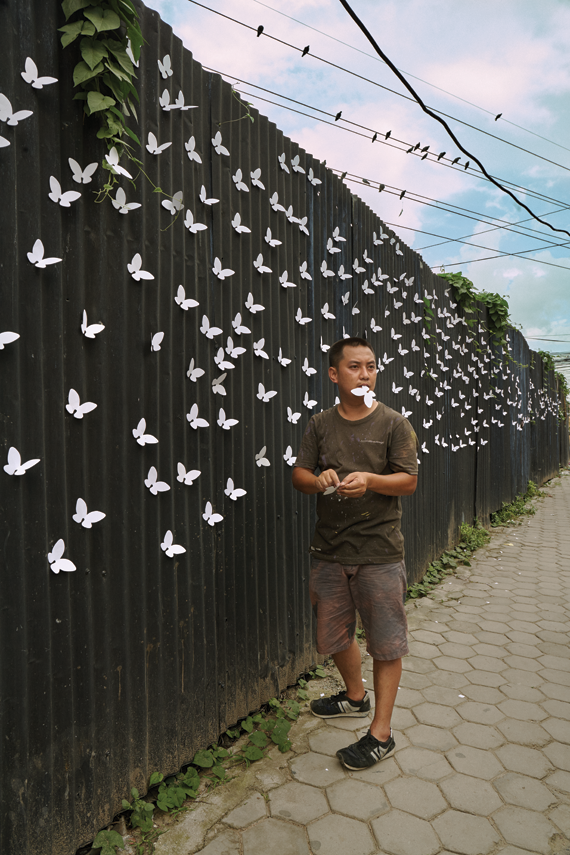
Age: 30
Profession: Artist
Location: Kathmandu, Nepal
How do you relate to Buddhism? I treasure the insights that Buddhism holds, but I am not a diligent Buddhist practitioner, nor am I into any particular religion. People ask me, “Do you meditate?” I respond, “I don’t stick myself into any strict postures.” Most of the time I am playful. When I see an ant crawling on my body, I let it travel peacefully. Or I lift it and gently shift it to some other place. That is a meditation.
You’re best known for the white butterfly movement. What is it, and how did it come into existence? While I was working in my studio, pondering some complex art project, a small white butterfly landed on my paintbrush. I was thinking of creating a very intense piece of art to shock my audience. But then this tiny creature came in, and I forgot what I was doing and became happy. This little butterfly was teaching me so much.
Art has become very limited: it appears in the same galleries and is seen by the same invited circles. I have always believed that art should be for everyone. So I thought that this time the uninvited would be my guests, and I started putting white butterflies in public spaces in the city, like billboards and trees.
The white butterflies ended up drawing people’s attention in an immediate way, taking them out of their daily routines for a moment and bringing them simple poetry from an unexpected place. People became curious about them. They started asking questions, conversations began, and as more people discovered the work through personal encounters and social media, the project began to take on a life of its own. Now the butterflies have gone to 41 countries and counting, as a message of love and hope and peace. I did not plan any of that, though—it all happened spontaneously and organically.
You’ve traveled along with the butterflies around the world. Have any particular experiences stayed with you? Here is a heartfelt story: The first international journey the butterfly made was to Scotland. A woman said I had inspired her to make her own butterfly and asked me if she could write the name of her daughter on its wings. At the time, many companies were asking me to collaborate with them and make the butterfly a logo, to turn it into a money-making business. But I didn’t want to mix commerce with my emotions. Because of that I wouldn’t allow anyone to do anything with my butterfly. So I told her no. But then I asked her why she wanted to write her daughter’s name on the butterfly. She said, “Tomorrow is the sixth anniversary of my daughter’s death. I want to write her name on a butterfly and put it on a tree.” I was so touched. I told her, “Please, please, do this. I’m sorry for being insensitive.” She did it, and one day an old man saw the butterfly on the tree and asked, “What is this?” She said, “This is a tribute to my daughter.” “I want to write a name,” he said. And then another one came: “I want to write the name of my grandmother.” Soon the tree was covered with butterflies bearing the names of loved ones. It has become a ritual: a memory tree to honor those who have been lost.
Tell me about your work in the aftermath of the April earthquake. I know you’ve been constructing temporary toilets. After the earthquake, people needed immediate relief, rescue, and food. But toilets? Nobody thought about toilets. These small things can be overlooked in emergency situations. One evening three days after the quake, I went with a friend to survey the situation at the open ground of Tudikhel, where thousands of people had set up makeshift camps. The only sanitation facilities available were four public toilets.
The next morning some friends and I began building emergency latrines. We were not experts. We were just concerned about public health and people’s dignity, because many girls had told me, “We have to wait till dark to relieve ourselves.” One girl was refusing to eat because she didn’t have a toilet to use. We appealed for volunteers on Facebook and Twitter, and in an hour people started coming from their houses, armed with tools. By seven p.m. we had built 47 toilets.
Now people around the world are creating butterfly installations and sending prayers and funds for the toilet project and other relief efforts to Nepal. They are using the butterfly as a symbol of solidarity and love. People have started calling me the Toilet Man, and I am also known as the Butterfly Man. But it doesn’t matter to me whether I’m a butterfly man or a toilet man. [Laughs.] I had always wanted to become a great artist, but now I want to become a good human being.
♦
Interview by Julia Worcester, Editorial Intern